Related Research Articles

Catherine de' Medici was an Italian (Florentine) noblewoman born into the Medici family. She was Queen of France from 1547 to 1559 by marriage to King Henry II and the mother of French kings Francis II, Charles IX, and Henry III. The years during which her sons reigned have been called "the age of Catherine de' Medici" since she had extensive, if at times varying, influence on the political life of France.
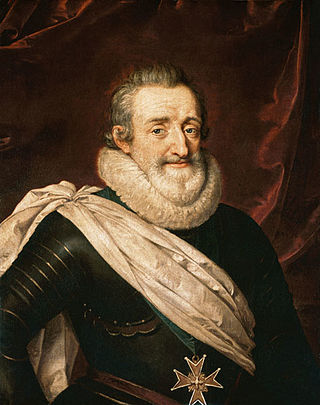
The Edict of Nantes was signed in April 1598 by King Henry IV and granted the minority Calvinist Protestants of France, also known as Huguenots, substantial rights in the nation, which was predominantly Catholic.

Henry IV, also known by the epithets Good King Henry or Henry the Great, was King of Navarre from 1572 and King of France from 1589 to 1610. He was the first monarch of France from the House of Bourbon, a cadet branch of the Capetian dynasty. He pragmatically balanced the interests of the Catholic and Protestant parties in France as well as among the European states. He was assassinated in 1610 by a Catholic zealot, and was succeeded by his son Louis XIII.

Charles IX was King of France from 1560 until his death in 1574. He ascended the French throne upon the death of his brother Francis II in 1560, and as such was the penultimate monarch of the House of Valois.
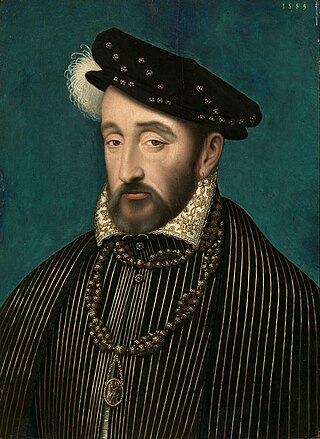
Henry II was King of France from 1547 until his death in 1559. The second son of Francis I and Duchess Claude of Brittany, he became Dauphin of France upon the death of his elder brother Francis in 1536.

The French Wars of Religion were a series of civil wars between French Catholics and Protestants from 1562 to 1598. Between two and four million people died from violence, famine or disease directly caused by the conflict, and it severely damaged the power of the French monarchy. One of its most notorious episodes was the St. Bartholomew's Day massacre in 1572. The fighting ended with a compromise in 1598, when Henry of Navarre, who had converted to Catholicism in 1593, was proclaimed King Henry IV of France and issued the Edict of Nantes, which granted substantial rights and freedoms to the Huguenots. However, Catholics continued to disapprove of Protestants and of Henry, and his assassination in 1610 triggered a fresh round of Huguenot rebellions in the 1620s.
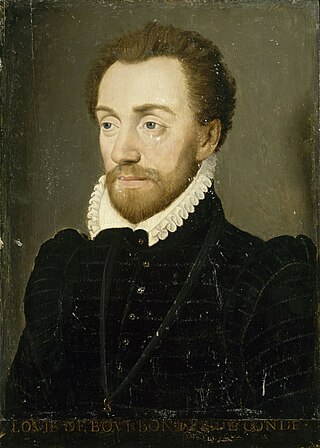
Louis de Bourbon, 1st Prince of Condé was a prominent Huguenot leader and general, the founder of the Condé branch of the House of Bourbon. Coming from a position of relative political unimportance during the reign of Henri II, Condé's support for the Huguenots, along with his leading role in the conspiracy of Amboise and its aftermath, pushed him to the centre of French politics. Arrested during the reign of Francis II then released upon the latter's premature death, he would lead the Huguenot forces in the first three civil wars of the French Wars of Religion before being executed after his defeat at the Battle of Jarnac in 1569.
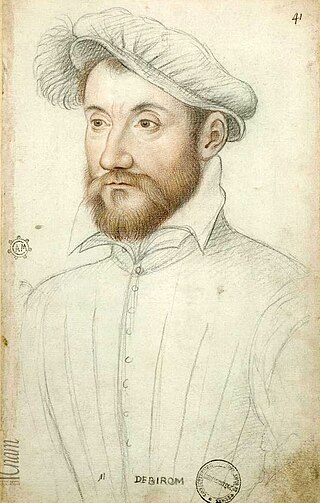
Armand de Gontaut, Baron of Biron was a soldier, diplomat and Marshal of France. Beginning his service during the Italian Wars, Biron served in Italy under Marshal Brissac and Guise in 1557 before rising to command his own cavalry regiment. Returning to France with the Peace of Cateau-Cambrésis he took up his duties in Guyenne, where he observed the deteriorating religious situation that was soon to devolve into the French Wars of Religion. He fought at the Battle of Dreux in the first civil war. In the peace that followed he attempted to enforce the terms on the rebellious governorship of Provence.
The Edict of Beaulieu was promulgated from Beaulieu-lès-Loches on 6 May 1576 by Henry III of France, who was pressured by Alençon's support of the Protestant army besieging Paris that spring.

The Peace of Saint-Germain-en-Laye was signed on 8 August 1570 by Charles IX of France, Gaspard II de Coligny and Jeanne d'Albret, and ended the 1568 to 1570 Third Civil War, part of the French Wars of Religion.
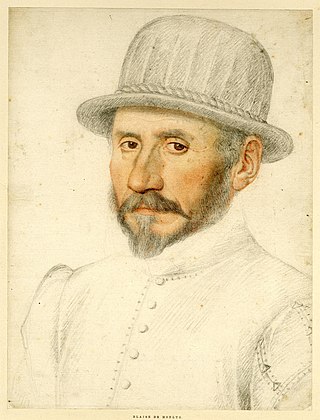
Blaise de Monluc, also known as Blaise de Lasseran-Massencôme, seigneur de Monluc, was a professional soldier whose career began in 1521 and reached the rank of marshal of France in 1574. Written between 1570 and 1576, an account of his life titled Commentaires de Messire Blaise de Monluc was published in 1592, and remains an important historical source for 16th century warfare.
The Edict of Boulogne, also called the Edict of Pacification of Boulogne and the Peace of La Rochelle, was signed in June 1573 by Charles IX of France in the Château de Madrid in the Bois de Boulogne. It was officially registered by the Parlement of Paris on 11 August 1573. The treaty officially ended the fourth phase of the French Wars of Religion.
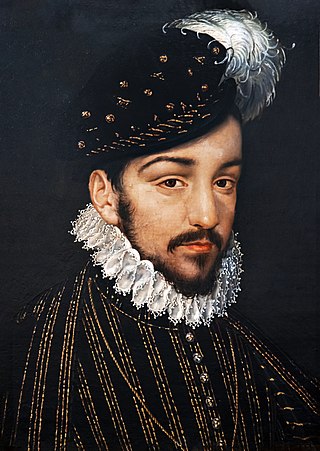
The Peace of Longjumeau was signed on 23 March 1568 by Charles IX of France and Catherine de' Medici. The edict brought to an end the brief second French Wars of Religion with terms that largely confirmed those of the prior edict of Amboise. Unlike the previous edict it would not be sent to the Parlements to examine prior to its publication, due to what the crown had felt was obstructionism the last time. The edict would not however last, and it would be overturned later in the year, being replaced by the Edict of Saint-Maur which outlawed Protestantism at the beginning of the third war of religion.
The Treaty of Hampton Court was signed on 22 September 1562 between Queen Elizabeth and Huguenot leader Louis I de Bourbon, prince de Condé. The treaty was concluded by François de Beauvais, Seigneur de Briquemault. Based on the terms of the accord, 3000 English troops were summoned to occupy Le Havre and Dieppe. Moreover, Queen Elizabeth promised to provide economic aid to the Huguenots. Once peace was restored in France, Elizabeth refused to withdraw her troops, stating that she had taken Le Havre not for religious reasons but to indemnify her for the loss of Calais, which was rightfully hers. The regent of France, Catherine de' Medici sent both Catholic and Huguenot troops against Le Havre, which surrendered on 28 July 1563. Feeling betrayed by the Huguenots, Elizabeth never trusted them again. This is evident when in 1572, Catherine de Medici ordered the killing of the Protestant Coligny. This resulted in 3000 Protestants being killed in what is known as the Massacre of St Bartholomew's Day. Elizabeth was urged to send support to the French Huguenots but refused.

The siege of La Rochelle of 1572–1573 was a massive military assault on the Huguenot city of La Rochelle by Catholic troops during the fourth phase of the French Wars of Religion, following the August 1572 St. Bartholomew's Day massacre. The conflict began in November 1572 when inhabitants of the city refused to receive Armand de Gontaut, baron de Biron, as royal governor. Beginning on 11 February 1573, the siege was led by the Duke of Anjou. Political considerations following the duke's election to the throne of Poland in May 1573 resulted in negotiations, culminating on 24 June 1573, that lifted the siege on 6 July 1573. The Edict of Boulogne signed shortly thereafter brought an end to this phase of the civil war.
Roger de Saint-Lary, baron de Bellegarde (1525-1579) was a soldier and Marshal of France. Rising to prominence as a favourite of Henri III he was quickly elevated to high office, becoming Marshal in 1574. Tasked with leading the main royal army in the fifth war of religion, he was not able to achieve success and the army disintegrated while he attempted to besiege Livron. Fighting again for the crown in 1577 he remained unable to achieve notable success on the battlefield. Having attempted to seize the Marquisate of Saluzzo which he had relinquished in hopes of attaining the governorship of Languedoc, he was granted the territory in a mediated settlement overseen by the duke of Savoy in October 1579. Several months later he would be dead.
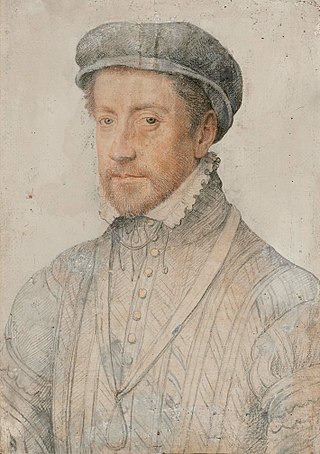
Louis de Bourbon, Duc de Montpensier was the second Duke of Montpensier, a French Prince of the Blood, military commander and governor. He began his military career during the Italian Wars, and in 1557 was captured after the disastrous battle of Saint-Quentin. His liberty restored he found himself courted by the new regime as it sought to steady itself and isolate its opponents in the wake of the Conspiracy of Amboise. At this time Montpensier supported liberalising religious reform, as typified by the Edict of Amboise he was present for the creation of.
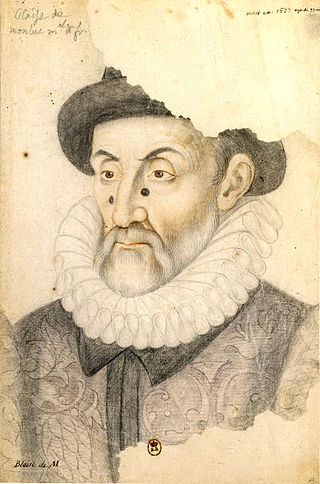
The Battle of Vergt took place on 9 October 1562 in the early stages of the French Wars of Religion, between a Royalist army led by Blaise de Montluc and Huguenot rebels under Symphorien de Duras. The battle was a decisive Royalist victory, which destroyed Duras' army, and prevented him reinforcing Protestant forces in the Loire Valley led by Gaspard II de Coligny and Condé. As such, it is considered a turning point in the first French War of Religion.
Poitiers is a city in France.

Jean de Morvillier, bishop of Orléans was a French noble, prelate, diplomat and de facto chancellor during the latter Italian Wars and early French Wars of Religion. Born into a prominent robe noble family, Morvillier began his royal service during the reign of François I, serving first as maître des requêtes for the king, and then ambassador to Venezia from 1546 to 1550. Early in the reign of François' successor he was granted the bishopric of Orléans as a reward for his service. While he would largely be an absentee bishop, he appointed vicars to govern his See in his stead. Throughout the next years he conducted himself as a diplomat, negotiating the Treaty of Angers with England in 1551, and later the Treaty of Cateau-Cambrésis in 1559 that brought the Italian Wars to a close.
References
- Salmon, J. H. M. Peasant Revolt in Vivarais, 1575–1580. French Historical Studies, Vol. 11, No. 1, (Spring 1979). Duke University Press.
- Knecht, R. J. The French Civil Wars (2000) Pearson Education Limited.